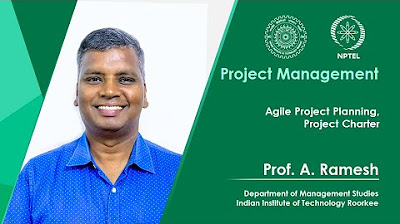Waterfall Project Management Explained | All You Need To Know (in 5 mins!)
Summary
TLDRThis video explains the Waterfall project management methodology using an Ocean's-style casino heist as an engaging example. Waterfall is a linear, step-by-step process, ideal for projects with well-defined tasks and minimal changes. The methodology consists of five phases: project initiation, planning, execution, monitoring, and closing. The video highlights the pros, such as clear goals and thorough documentation, and cons, like inflexibility. By following the example of a meticulously planned casino heist, viewers gain insights into when and how to apply Waterfall for structured project management.
Takeaways
- 💧 Waterfall is a project management approach best for teams working with clear, well-defined tasks in a linear process.
- 📜 Waterfall follows a sequential process broken down into five phases: project initiation, planning, execution, monitoring & controlling, and closing.
- 🔍 Waterfall is ideal for projects with fixed requirements and milestones that don't change often, making it less suitable for dynamic environments.
- 📄 The methodology emphasizes thorough documentation for accountability and traceability throughout the project lifecycle.
- 📈 The project initiation phase involves gathering requirements, mapping goals, and defining stakeholders, usually led by a project manager and a business analyst.
- 🛠️ The planning phase involves creating a detailed, step-by-step project plan, assigning tasks, and ensuring the necessary technology is in place.
- 🚀 In the execution phase, tasks are carried out, and challenges may arise, which is why project managers must closely monitor progress.
- ⏲️ Monitoring and controlling are critical to ensuring tasks are completed on time, budgets are adhered to, and quality is maintained.
- 🎉 The closing phase includes finalizing deliverables, reviewing project success, and conducting a retrospective to learn from the project.
- 🏛️ Waterfall is best suited for projects with regulatory or compliance requirements, where minimizing changes and maintaining control is crucial.
Q & A
What is the Waterfall methodology in project management?
-The Waterfall methodology is a sequential approach to project management where each phase of the project flows into the next, much like a waterfall. It consists of five phases: initiation, planning, execution, monitoring and controlling, and closing.
What types of projects are best suited for the Waterfall methodology?
-Projects with well-defined, clear requirements and where changes are minimal are best suited for Waterfall. This includes industries that require strict regulations and compliance, as well as projects where it’s important to limit iterations and interruptions to the workflow.
What are the five phases of the Waterfall methodology?
-The five phases of the Waterfall methodology are: 1) Project initiation or requirements phase, 2) Project planning or system design phase, 3) Project execution phase, 4) Project monitoring and controlling phase, and 5) Project closing phase.
What is the primary advantage of using the Waterfall methodology?
-The primary advantage of using the Waterfall methodology is its emphasis on well-defined requirements, which helps avoid ambiguity, establish clear goals, and reduce inefficiency.
Why is documentation important in the Waterfall methodology?
-Documentation is crucial in Waterfall because it provides visibility, accountability, and traceability for every step of the project. It is particularly helpful if stakeholders need information on how, why, or when a specific decision was made.
What is a major drawback of the Waterfall methodology?
-A major drawback of the Waterfall methodology is its inflexibility. Once a phase has been completed, it is difficult to go back and make changes, making it less suitable for dynamic projects where requirements and milestones may change frequently.
How does the Waterfall methodology handle project execution?
-In the project execution phase, the project manager holds an official kickoff, and the team begins working through the project tasks. This phase is critical as it involves carrying out the plan laid out in the earlier phases while adhering to the timeline and budget.
What role does the project manager play during the monitoring and controlling phase?
-During the monitoring and controlling phase, the project manager ensures tasks are completed on time, manages the budget, and maintains project quality. If anything goes off track, the project manager adjusts and guides the team to keep the project on course.
How is the closing phase handled in a Waterfall project?
-In the closing phase, the team confirms that all project objectives have been met, holds a retrospective to celebrate successes and identify areas for improvement, and archives final deliverables and documentation for future reference.
When should a team avoid using the Waterfall methodology?
-Teams should avoid using Waterfall for projects that are dynamic, where requirements and milestones change frequently. Waterfall’s rigid structure makes it difficult to accommodate significant changes after a phase is completed.
Outlines

Этот раздел доступен только подписчикам платных тарифов. Пожалуйста, перейдите на платный тариф для доступа.
Перейти на платный тарифMindmap

Этот раздел доступен только подписчикам платных тарифов. Пожалуйста, перейдите на платный тариф для доступа.
Перейти на платный тарифKeywords

Этот раздел доступен только подписчикам платных тарифов. Пожалуйста, перейдите на платный тариф для доступа.
Перейти на платный тарифHighlights

Этот раздел доступен только подписчикам платных тарифов. Пожалуйста, перейдите на платный тариф для доступа.
Перейти на платный тарифTranscripts

Этот раздел доступен только подписчикам платных тарифов. Пожалуйста, перейдите на платный тариф для доступа.
Перейти на платный тарифПосмотреть больше похожих видео

Waterfall methodology, explained

7 Important Project Management Methodologies You Need To MASTER

Software Project Management - Why it's Different!

METODOLOGÍAS DEL DESARROLLO DE SOFTWARE - ANÁLISIS Y DISEÑO

Introduction to Survey Research (Federico Caniato)

Lecture 14 : Agile Project Planning, Project Charter
5.0 / 5 (0 votes)
